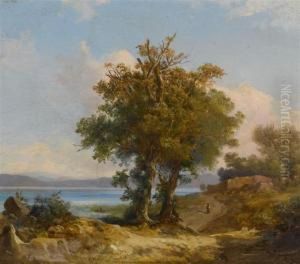Charles Henry Poingdestre Paintings
Charles Henry Poingdestre was a British artist, born in 1829 in Jersey, a British Crown Dependency located off the coast of Normandy, France. His work is often remembered for its intricate detailing and the ability to capture the essence of his subjects, which ranged from landscapes to portraits. Poingdestre showed an early interest in art, and despite the limited opportunities available on the island at the time, he pursued his passion with great fervor.
Educated locally, Poingdestre's talent was evident from an early age. However, it was his move to London that truly marked the beginning of his professional career. In London, he was exposed to the vibrant art scene of the 19th century, a period known for its diverse artistic movements and innovations. This exposure played a crucial role in shaping his artistic style and approach. Poingdestre was particularly influenced by the Romanticism movement, which is reflected in his dramatic use of light and shadow, as well as the emotional depth of his work.
Throughout his career, Poingdestre participated in numerous exhibitions, showcasing his work alongside contemporaries who would go on to become some of the most celebrated artists of their time. His paintings were well-received, earning him recognition and accolades. Despite this, Poingdestre remained somewhat of an outsider in the art world, often preferring the solitude of his studio or the serene landscapes of Jersey to the bustling art circles of London.
Returning to Jersey later in his life, Poingdestre continued to paint, drawing inspiration from the island's unique landscapes and seascapes. His later works are characterized by a more subdued palette and a contemplative quality, reflecting his deep connection to his homeland and perhaps a sense of introspection in his later years.
Charles Henry Poingdestre passed away in 1905, leaving behind a legacy of work that continues to be appreciated for its beauty and emotional resonance. Although not as widely known as some of his contemporaries, his contributions to the art world are significant, offering a glimpse into the rich tapestry of 19th-century British art. His works remain in collections and galleries, cherished by art lovers for their timeless appeal and the window they offer into the artist's soul.










